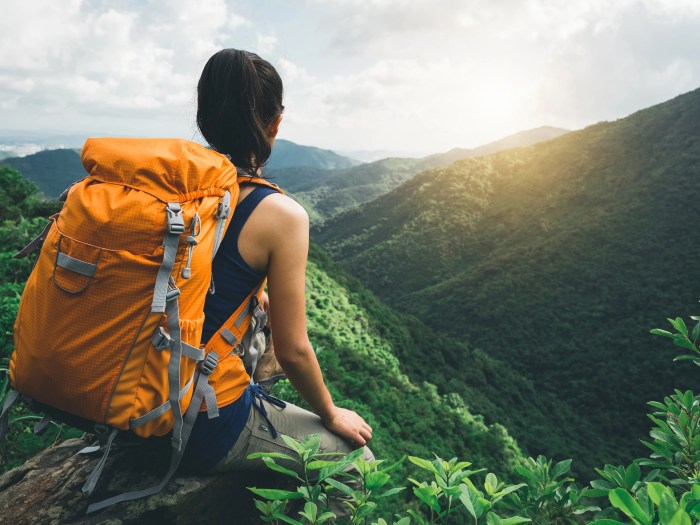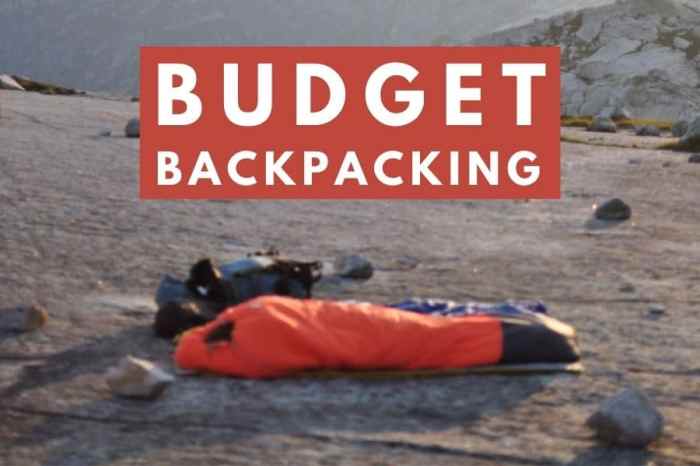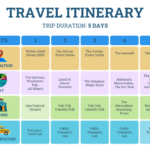Cheap Backpacking Trips: Unlocking incredible adventures doesn’t require a king’s ransom. This guide reveals how to experience the thrill of backpacking without breaking the bank. We’ll dissect budgeting strategies, pinpoint affordable destinations, and equip you with savvy tips to maximize your travel experience while minimizing expenses. Get ready to explore the world on a shoestring, discovering hidden gems and creating unforgettable memories without the hefty price tag.
From meticulously crafted budgets to uncovering secret spots offering incredible value, we’ll cover everything you need to know. Learn how to navigate affordable accommodation, eat like a local without emptying your wallet, and find free or low-cost activities that enrich your journey. We’ll even delve into essential safety precautions, ensuring your adventure is both exhilarating and responsible.
Budgeting for a Cheap Backpacking Trip
Planning a backpacking trip on a shoestring budget requires meticulous attention to detail. Understanding where your money goes is the first step to maximizing your travel experience without breaking the bank. This involves creating a realistic budget and employing effective cost-saving strategies across all aspects of your journey. Remember, even seemingly small savings can accumulate significantly over the course of a week.
Sample Budget Breakdown for a Week-Long Backpacking Trip
Let’s consider a hypothetical week-long backpacking trip to Southeast Asia, a region known for its affordability. This example demonstrates a budget-conscious approach, focusing on maximizing value and minimizing unnecessary expenses. Note that prices are estimates and can vary depending on the specific location and time of year.
| Budget Category | Estimated Cost (USD) | Notes |
|---|---|---|
| Accommodation (Hostels/Guesthouses) | $70 | Average $10/night for a dorm bed or budget private room. |
| Food (Street food, local markets) | $70 | Focus on affordable street food and local markets for significant savings. |
| Transportation (Buses, local trains) | $50 | Avoid taxis and opt for public transportation whenever possible. |
| Activities (Free walking tours, hiking) | $20 | Prioritize free or low-cost activities like hiking and exploring local neighborhoods. |
| Miscellaneous (Souvenirs, SIM card) | $40 | Allocate a small budget for unexpected expenses. |
| Total Estimated Cost | $250 | This is a conservative estimate; costs can be lower or higher depending on your choices. |
Comparing Fixed and Flexible Budgeting Methods
Two primary budgeting approaches exist for backpacking trips: fixed and flexible. A fixed budget involves setting a specific amount for each category and strictly adhering to it. This offers greater control and prevents overspending. Conversely, a flexible budget allows for more spontaneity, with some categories having more leeway than others. This provides adaptability, particularly useful when encountering unexpected opportunities or challenges.
The best method depends on your personality and travel style. A fixed budget might be preferable for disciplined travelers prioritizing cost control, while a flexible budget suits those who prefer a more spontaneous approach.
Cost-Saving Strategies for Backpacking Trips
Employing effective cost-cutting strategies is crucial for maximizing your budget. The following table Artikels potential savings across various categories.
| Budget Category | Cost-Saving Strategy 1 | Cost-Saving Strategy 2 | Cost-Saving Strategy 3 |
|---|---|---|---|
| Accommodation | Stay in hostels or guesthouses instead of hotels. | Utilize websites offering discounted rates or last-minute deals. | Consider couchsurfing or house-sitting for free accommodation. |
| Food | Eat at local markets and street food stalls. | Cook your own meals whenever possible. | Take advantage of free breakfast options offered by some hostels. |
| Transportation | Utilize public transportation (buses, trains). | Walk or cycle whenever feasible. | Consider overnight buses to save on accommodation costs. |
| Activities | Take advantage of free activities like hiking and exploring parks. | Look for free walking tours in major cities. | Take advantage of free museum days or discounted admission. |
Choosing a Cheap Backpacking Destination

Selecting the right destination is paramount for a successful and budget-friendly backpacking trip. The cost of travel, accommodation, and food can vary drastically depending on your location. Careful consideration of factors like visa requirements, accessibility, and safety is crucial for maximizing your travel experience while minimizing expenses. This section will analyze three affordable backpacking destinations in Southeast Asia, providing a detailed comparison to aid in your decision-making process.
Southeast Asian Backpacking Destinations: A Cost-Benefit Analysis
Southeast Asia consistently ranks among the most affordable regions for backpacking, offering a diverse range of experiences from bustling cities to serene beaches and lush jungles. This analysis focuses on three popular choices: Thailand, Vietnam, and Laos. Each destination presents a unique blend of advantages and disadvantages concerning cost, accessibility, and safety.
Thailand
Thailand boasts a well-developed tourist infrastructure, making it incredibly accessible. Numerous budget airlines connect major cities, and internal transportation via buses and trains is efficient and inexpensive. Accommodation options range from budget-friendly hostels to more comfortable guesthouses, catering to various budgets. Food is remarkably cheap, with delicious street food readily available throughout the country. However, popular tourist areas can be crowded, and certain areas might experience higher prices.
Safety is generally good, but travelers should exercise typical precautions against petty theft, especially in crowded areas.
Vietnam
Vietnam offers a similar level of affordability to Thailand, but with a slightly different character. The country is known for its stunning natural beauty, including breathtaking rice paddies, limestone karsts, and beautiful beaches. Transportation is efficient and relatively inexpensive, with a well-developed network of buses and trains. Accommodation is readily available and budget-friendly, particularly in hostels and guesthouses.
Food is incredibly cheap and diverse, offering a unique culinary experience. Safety is generally high, but as with any travel destination, awareness of surroundings is recommended.
Laos
Laos provides a more laid-back and less touristy experience compared to Thailand and Vietnam. It’s a perfect choice for travelers seeking a slower pace and a more authentic cultural immersion. While transportation might be slightly less developed than in Thailand or Vietnam, it’s still affordable and readily available. Accommodation options are generally budget-friendly, and food costs are consistently low.
The relative lack of tourism contributes to lower prices and a more tranquil atmosphere. However, accessibility to certain areas might be more challenging than in Thailand or Vietnam. Safety is generally good, but travelers should be aware of potential scams, particularly in tourist areas.
Comparison Table: Thailand, Vietnam, and Laos
| Factor | Thailand | Vietnam | Laos |
|---|---|---|---|
| Visa Requirements (for most nationalities) | Visa on arrival or visa exemption for short stays | Visa on arrival or visa exemption for short stays | Visa on arrival or visa exemption for short stays |
| Local Transportation Costs (daily) | $5-10 | $3-7 | $3-8 |
| Average Daily Expenses (excluding flights) | $25-50 | $20-40 | $15-35 |
Free and Low-Cost Activities
Backpacking doesn’t have to break the bank. In fact, some of the most memorable travel experiences are the ones that cost the least. By embracing free and low-cost activities, you can stretch your backpacking budget further and immerse yourself in the local culture without sacrificing enjoyment. This section Artikels five budget-friendly activities perfect for enriching your backpacking adventure, transforming a potentially expensive trip into an affordable and rewarding one.
Five Free or Low-Cost Activities for Backpackers
The key to a successful and affordable backpacking trip lies in strategically choosing activities that don’t drain your funds. Here are five options that offer incredible value and unique experiences:
- Hiking: Explore the natural beauty surrounding your destination with a simple hike. This activity requires minimal equipment – sturdy shoes, water, and perhaps a map – and offers breathtaking views and a healthy dose of exercise. The cost is essentially zero, unless you need to purchase a trail map or pay for parking at a trailhead (usually under $10).
Imagine the stunning panoramic views from a mountain peak overlooking a picturesque valley, or the tranquility of a forest trail winding through ancient trees. The experience itself is priceless.
- Exploring Local Markets: Immerse yourself in the local culture by visiting farmers’ markets or open-air markets. These vibrant hubs offer a glimpse into the daily life of the community, showcasing local produce, crafts, and street food. The cost is minimal, primarily limited to the cost of any souvenirs or snacks you choose to purchase. The sensory experience alone – the sights, sounds, and smells – is invaluable, offering a far richer understanding than any tourist trap.
For instance, a bustling market in Marrakech might offer spices, textiles, and handcrafted jewelry at incredibly affordable prices, allowing you to bring back authentic mementos without breaking the bank.
- Visiting Free Museums and Historical Sites: Many cities and towns boast free museums or offer free admission days. These often provide insightful looks into local history, art, and culture. Check local tourism websites for details. While some museums might charge an entry fee, many offer free admission on certain days or evenings, or even completely free access for students or seniors. The cost here is largely dependent on the specific location, but the potential for learning and cultural immersion is significant.
Imagine exploring a historical castle in Europe, learning about its history and architecture without paying a hefty admission fee.
- Picnics in Parks or Scenic Spots: Pack your own lunch and enjoy a relaxing picnic in a park or scenic location. This simple activity is incredibly cost-effective and allows you to appreciate the beauty of your surroundings without the expense of a restaurant meal. The cost is limited to the groceries you purchase for your picnic. Think of a sunny afternoon spent in a charming park, enjoying a simple sandwich and the company of fellow travelers.
The cost is minimal, but the memories are priceless.
- Free Walking Tours: Many cities offer free walking tours, guided by passionate locals who share their knowledge and insights about the city’s history, architecture, and culture. While tips are appreciated, these tours are typically free to join. This is an invaluable way to gain a deeper understanding of your destination and discover hidden gems you might miss on your own. These tours often cover areas that are not typically highlighted in tourist guides, allowing you to discover the true character of the city.
The cost is entirely up to you, as tips are voluntary, but the knowledge and experience gained are far more valuable than any price tag.
Sample 3-Day Backpacking Itinerary Incorporating Free and Low-Cost Activities
This itinerary provides a framework for incorporating the above activities into a three-day backpacking trip. Remember to adjust it based on your chosen destination and interests.
- Day 1: Arrival and City Exploration. Settle into your accommodation and embark on a free walking tour to orient yourself with the city. In the evening, visit a local market to sample street food and soak in the atmosphere.
- Day 2: Hiking and Nature. Spend the day hiking in a nearby park or scenic area. Pack a picnic lunch to enjoy amidst the natural beauty. In the evening, look for a free museum or historical site to visit.
- Day 3: Cultural Immersion and Departure. Visit a free museum or explore additional parts of the city. Spend your last few hours browsing a local market for souvenirs before heading to the airport or bus station for your departure.
Packing Light and Smart: Cheap Backpacking Trips

Backpacking on a budget doesn’t mean sacrificing comfort or essential items. The key is strategic packing: maximizing functionality while minimizing weight and cost. By carefully selecting your gear and employing smart packing techniques, you can significantly reduce your luggage burden and travel more efficiently. This leads to a more enjoyable and less strenuous backpacking experience, allowing you to focus on the adventure itself, not the weight on your back.Packing light isn’t about deprivation; it’s about prioritization.
Every item you carry should serve a clear purpose and offer multiple functionalities where possible. Consider the climate, terrain, and duration of your trip when making your selections. Remember, less is often more when it comes to backpacking, especially on a budget.
Essential Items for a Cheap Backpacking Trip, Cheap Backpacking Trips
This section details the core items you’ll need for a successful and cost-effective backpacking adventure. Prioritizing versatility and durability will save you both space and money in the long run. Investing in high-quality, lightweight versions of essential items is often more economical in the long run than buying cheaper, heavier alternatives that may break or wear out quickly.
- Backpack (30-50 liters): Choose a durable, lightweight backpack with good ventilation and adjustable straps for a comfortable fit. Avoid overly large backpacks, as they encourage overpacking.
- Tent: A lightweight, single-person or two-person tent depending on your travel companions. Look for tents made of durable, water-resistant materials. Consider borrowing a tent from a friend or renting one if purchasing isn’t feasible.
- Sleeping Bag: Select a sleeping bag appropriate for the climate you’ll be backpacking in. Lightweight, synthetic fill sleeping bags offer a good balance of warmth, weight, and cost-effectiveness.
- Sleeping Pad: Provides insulation and comfort while sleeping on the ground. Inflatable pads are lightweight and packable, while foam pads offer more durability at a slightly higher weight.
- Clothing: Pack versatile clothing items that can be layered. This includes moisture-wicking base layers, a fleece jacket, a waterproof outer shell, hiking pants or shorts, and sturdy hiking boots or shoes. Avoid packing multiple outfits for each day; choose items that can be easily washed and dried.
- Cooking Supplies (optional): If you plan on cooking your own meals, a lightweight stove, pot, utensils, and a biodegradable soap are essential. Consider using lightweight, reusable food containers instead of disposable ones to reduce waste and costs.
- First-Aid Kit: Include essential medications, bandages, antiseptic wipes, pain relievers, and any personal medical supplies. A small, lightweight kit is sufficient for most trips.
- Headlamp or Flashlight: Essential for navigating in the dark.
- Water Bottle or Hydration Reservoir: Staying hydrated is crucial. A reusable water bottle or hydration reservoir is more economical and environmentally friendly than purchasing bottled water.
- Map and Compass/GPS Device: Navigation tools are essential, even in familiar areas. A map and compass are lightweight and reliable, while a GPS device offers additional functionality but adds weight and cost.
Space-Saving Techniques
Efficient packing is crucial for minimizing luggage weight. Using packing cubes or compression sacks can significantly reduce the volume of your clothing and gear. Rolling your clothes instead of folding them can also save space and reduce wrinkles. Consider using vacuum-sealed bags for bulky items like jackets or sleeping bags.
Minimizing Luggage Weight Without Sacrificing Essential Items
The weight of your backpack directly impacts your comfort and enjoyment of the trip. To minimize weight, prioritize lightweight gear. Choose items made of durable, lightweight materials such as nylon or ripstop fabric. Avoid unnecessary items. Only pack what you absolutely need.
Before packing, lay out all your items and critically evaluate each one. Ask yourself: “Do I really need this?” If the answer is no, leave it behind.
Mastering the art of cheap backpacking isn’t about sacrificing experiences; it’s about strategic planning and resourcefulness. By implementing the budget-friendly techniques Artikeld here, you can transform your travel dreams into reality. Remember, the most rewarding journeys are often the ones that challenge you to think creatively and embrace the unexpected. So, pack your bags, embrace the adventure, and discover the world on your terms—without the exorbitant cost.

